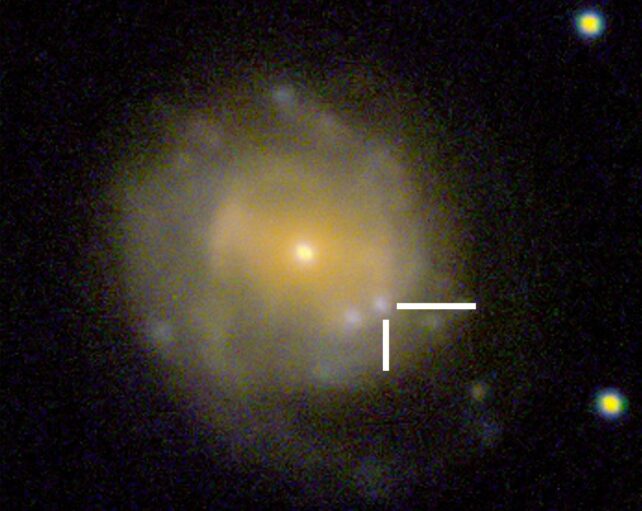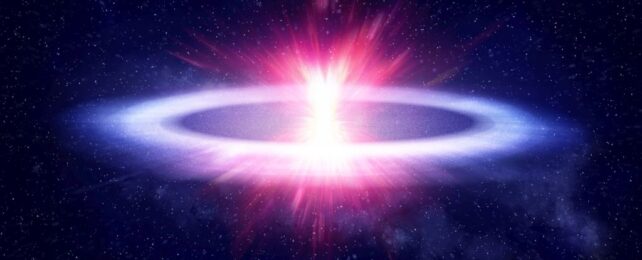An explosion that took place in a galaxy 180 million light-years away is challenging our understanding of how stars die, appearing to represent the flattest explosion of its kind on record.
The monumental kaboom named AT2018cow belonged to an extremely rare class of cosmic blasts known as fast blue optical transients, or FBOTs. Unlike the other four FBOTs detected to date, however, AT2018cow seems to have only exploded out sideways for some reason.
The result is an eruption shaped not like a sphere, as we might expect from the explosion of a spherical object such as a star, but a disk. Since we don't know what produces such weirdly shaped explosions, this discovery could help astronomers narrow down potential progenitors.
"Very little is known about FBOT explosions – they just don't behave like exploding stars should, they are too bright and they evolve too quickly. Put simply, they are weird, and this new observation makes them even weirder," says astrophysicist Justyn Maund of the University of Sheffield in the UK, who led the research.
"Hopefully this new finding will help us shed a bit more light on them - we never thought that explosions could be this aspherical. There are a few potential explanations for it: the stars involved may have created a disk just before they died or these could be failed supernovas, where the core of the star collapses to a black hole or neutron star which then eats the rest of the star."
AT2018cow – nicknamed "the Cow" – was the first of these explosions ever detected, back in 2018, and it was immediately identified as extremely odd. It was exceptionally bright, so much so that it was initially thought to have taken place much closer to us. It looked a lot like a normal supernova explosion in some ways, but astronomers later found it was 10 times more powerful.
It also flared and then faded a lot more quickly than a normal supernova, and was incredibly hot, which gave the light it emitted a significantly bluer tint than usually seen from normal supernovae. These traits are shared in common with the other FBOTs since detected.
Although explanations for the peculiar explosion have been proposed, we're still not entirely sure what causes FBOTs, so astronomers are continuing to look at the data collected during each event to try to get to the bottom of it.
Maund and his team performed a deep dive on the Cow's polarization data obtained using the Liverpool Telescope. This is the extent to which the orientation of the light's waves has become twisted, and it can reveal information about the environment in which the light formed, and through which it traveled on its long journey to our telescope detectors.

This polarization was extremely high and recorded at multiple wavelengths multiple times over the first night of observations following the explosion, and then in the days after. This allowed the researchers to reconstruct the three-dimensional shape of the explosion. Curiously, they observed a 'bump' in the polarization in blue wavelengths at the 12-day mark – a feature that could only result from an extremely aspherical geometry.
It was the profile of the polarization that led the team to conclude the Cow's unusual shape, posing a mystery.
We have a handful of FBOT detections, which means we're likely to detect more in the future, especially with instruments such as the powerful Vera C. Rubin Observatory. Due to commence operations next year, it will survey the sky looking for transient events like FBOTs, among other things.
Analysis of the polarization data of these events could reveal whether the Cow is typical of this type of explosion, or whether, even among the oddballs, it was even odder.
"What we now know for sure is that the levels of asymmetry recorded are a key part of understanding these mysterious explosions," Maund says, "and it challenges our preconceptions of how stars might explode in the Universe."
The research has been published in the Monthly Notices of the Royal Astronomical Society.
